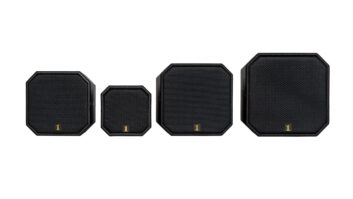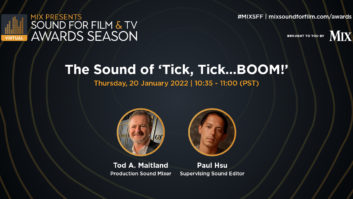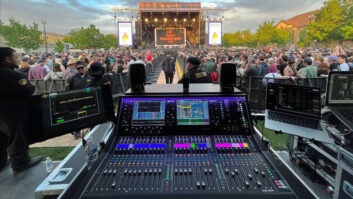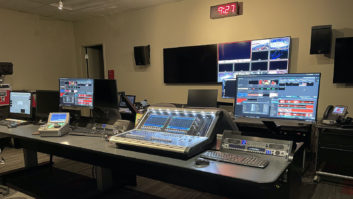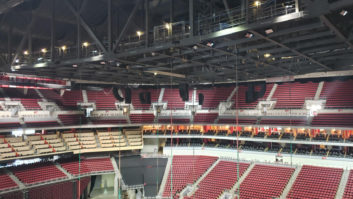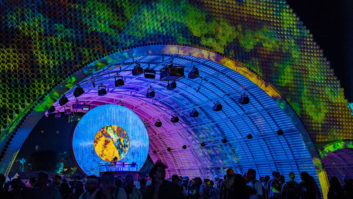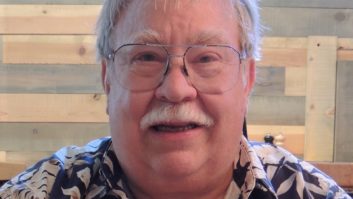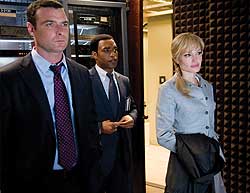
There’s been no shortage of action movies over the past couple of decades, with dozens of subgenres proliferating to satisfy the audience’s appetite for war, worldwide destruction, comic books, videogames, legal procedure, historical epic, serial killers, mistaken identity or underdogs fighting the good fight against all odds. But it’s a relatively short list when looking through the legacy of intelligent, character-driven action-thrillers, in the vein of Three Days of the Condor, The French Connection, The Fugitive and the Bourne franchise.
Australian director Phillip Noyce entered the club with his smart, story-driven Jack Ryan films, Patriot Games and Clear and Present Danger from the early ’90s. Now he’s back, and he’s hurtling through modern-day spy territory—practically ripped from today’s Soviet spy exchange headlines—with Angelina Jolie on the run in Sony Pictures’ summer blockbuster Salt.
“My first reaction, on seeing an early cut, was, ‘Wow!’” recalls Greg P. Russell, effects re-recording mixer from the Kim Novak Theatre on the Sony lot in mid-July. “It’s exciting, well-paced, authentic and realistic. The action is believable, and it’s a solid story, really solid, with twists and turns that kept me guessing through to the end. And I loved the Salt character. Unique and clever, smart and bold. Angelina Jolie does such a great job with this role, and the film is filled front to back with incredible sound opportunities.”

From left: Igor Nikolic, first sound assistant; Scott Millan music mixer; Philip Stockton, supervising sound editor; Jeffrey J. Haboush, dialog mixer; Deborah Wallach, ADR supervisor; Phillip Noyce, Director; Greg P. Russell, effects mixer, Paul Hsu, supervising sound Editor; Joe E. Rand, music editor
Photo: Tom Burns
Russell was joined at the Harrison MPC by Jeff Haboush on dialog, a mixer he’s teamed with on and off for nearly 27 years, and Scott Millan, a veteran of the Bourne films and a hit man brought in to handle music. In essence, it was a return to the three-person crew that was the norm not so long ago in Hollywood. Noyce called the track the most complex in his career, and his vision was established clearly from the beginning.
“On day one, Phillip laid out the game plan,” Russell recalls. “Story and character were key, and everything we did in the soundtrack had to support her story. She is a CIA agent accused of being a Russian spy, and she’s on the run trying to clear her name. So all the tension that we feel, whether it’s coming from effects and high-octane car chases and bullet whiz-bys, or the group dialog with its precise, story-specific lines, or the music with its big brass and intense rhythms—we need to feel that threat she is experiencing throughout the film. He laid it out in a way that we were on the same page from the first temp dub.”
MUSIC AS CHARACTER
“The movie was sold by Sony Pictures using the tag, ‘Who is Salt?’ And that’s really what the movie is about,” says Noyce. “It’s an investigation into the character of Evelyn A. Salt. She may be what she claims to be: an American patriot, a clandestine operative, a spy working for the CIA in foreign countries. Or she may well be what she is accused of: a Soviet-era laboratory rat bred in a secret camp in the last dark days of the KGB. Music augments that speculation about the true nature of her character, suggesting sometimes that she is more of an American patriot than she really is, and at other times suggesting there might be a darker side to her history. The music, in a sense, is following its own script, which is sometimes on the screen and sometimes isn’t.”
The film is a tight 93 minutes of story, with 91 minutes of score from James Newton Howard, edited by longtime Noyce collaborator Joe E. Rand and delivered from his stage-side Pro Tools rig at 60 channels wide, with clear separation of orchestra elements and electronic supplements. The challenge, according to music re-recording mixer Millan, was to propel story, drive character, but never let the audience know it.
“James Newton Howard and Joe E. Rand did a fantastic job,” says Millan, who migrated to film from a music background. “You never feel overwhelmed; you just feel subliminally engaged without ever feeling manipulated or telegraphed. Philip and James choreographed it in such a way that it plays into a perpetual sense of moving forward and keeping the tension high. The rhythm of the score as a whole was imperative. You never feel like you’re stopping, or that there is a beat out of line.”
“In this particular film, music drives the soundtrack, and that’s quite unusual for an action film, where usually it’s the effects that drive the sound,” Noyce adds. “The reason music drives the film is because I’ve used James Newton Howard’s score as the unifying factor to combine what is on the one hand fantastical, escapist popcorn entertainment, and on the other hand, a fact-based thriller—two seemingly irreconcilable genres that are pulled together and held tight by James’ score. Everything, in a sense, was subordinated to the music.”

EFFECTS AND PACE
While music drives the film, the effects track, and its give-and-take with the score, keeps the pace. At times it’s relentless, but it never turns bombastic. Phil Stockton and Paul Hsu, out of C5 in New York, co-supervised the film, with Hsu concentrating on design and Stockton overseeing the dialog and overall delivery at the final.
“I had never worked with them before,” says Russell, “and they delivered stellar material, sounds that put us in these very real environments. Some fantastic city sounds, and the technical wizardry of all these control rooms, the beeps and boops in the interiors. Great explosions, great vehicle sounds, and I really loved the gun work. I think people will notice that the weapons have a fat, punchy but crisp sound. You feel them in your chest without being overcooked.”
At the final, Russell went out to about 10 or 11 5.1-channel hard effects predubs at any one time, with another 40 channels of props and 40 channels of footsteps from the Foley team per reel. It’s a busy movie, filled with location shoots across a lot of urban environments, hand-to-hand combat, principals on the run and lots of crowds. “There are a lot of human beings in this movie,” Russell says, “and human beings can get busy. There had to be an enormous amount of Foley to bring out the detail, and Dan O’Connell and his team did an amazing job of walking this film.” Marko Costanzo assisted the Foley walking, with recording by George A. Lara.
Particular attention was also paid to backgrounds in this film, as the characters move constantly and the tracks serve to anchor the audience in reality. When Mix first visited the Novak Theatre in early June, Russell and Haboush had just started their first passes, and Russell was knee-deep in BGs, eventually ending up with four “5-3” predubs, meaning four each in a 5.0 and 3.0 format to give himself separation and flexibility at the final. The BGs also serve to spin the characters in and out of a few key flashback sequences that help illuminate character.
While BGs and Foley provide the glue for the effects track, in a very busy film such as Salt, it’s the big sequences that the audience will remember, and there is no shortage here. Though Noyce preached from the beginning that the track always needed to be looked at in its entirety, to the extent that he calls it remixing, a few key scenes stand out for Russell.
“I loved her initial escape sequence, where she goes over the overpass,” he says. “It’s in the trailer, so I’m not spoiling anything. But she launches herself off an overpass, lands on a semi truck, jumps from vehicle to vehicle while they chase her, then she crashes and is up and off on a motorcycle.
“Phil [Stockton] and his team also provided an array of very cool explosions,” he continues. “In one particular scene, at a pretty dramatic moment in the film, we have a design-reversed sound effect that ties right into a very crisp button-click with a high-frequency ping into a huge dynamic explosion. It’s a concussive impact that goes right through your body. It’s a unique sound, that concussive impact, and it’s one of my favorites in the movie. Then again, there are a lot of moments like that.”
By all accounts, Noyce has a discerning ear and was deeply involved, down to the most minute changes, in the track. He wanted to feel a lot of sound, and he wasn’t afraid to pan around the room to open up space for the audience to hear it all.
“I’ve always believed in using sound as an ‘emotionator,’ if I can make up a word,” Noyce laughs. “No sound is innocuous, no musical note is innocuous. They simply exist. Whether it’s the rustle of the wind, the sound of birds, the footsteps or the strings, they all have a dramatic and an emotional purpose within the soundtrack.
“We set out at the beginning of the sound work with a number of objectives,” he continues. “One was to ensure that as a ride, Salt is relentless. Once the audience gets on, we want the roller coaster to never stop. The audience has nowhere to hide, you just hold on and hope you get to the end with your brain intact. That means you are trying to create incessant rhythms of sound. There can be no pause. You’re trying to hit them and hit them and hit them as if you have them against a wall, punching them. But you want them to feel as if you’re just stroking them, because you want them on the edge of their seats wanting more. Every time they might want to feel like a pause, there’s another sound ricocheting into the next sound, that’s bouncing forward into the next one. And they keep going within a rhythm that’s relentless. The trick is to find the right level, and I don’t mean volume. I mean the right level of complexity without ever being bombastic.”

Effects re-recording mixer Greg P. Russell, a 13-time Oscar nominee, at the Harrison in the Kim Novak Theatre, Sony Pictures Studios.
Photo: David Goggin
DIALOG AND RHYTHM
There are a lot of principals and a lot of extras and group in the film, leading to what Haboush, a nearly 30-year veteran, calls “one of the most complicated mixes I’ve ever done.” He set up at the Harrison with seven predubs: dialog, ADR, two group, an x track, a futz track and a PFX (production effects) track.
“Phillip loves the cacophony and the layers, not only in effects, but in dialog, too,” Haboush says. “Real walkie-talkies with police calls. CB radios with squelch and static. TV monitors, newscasters, people in and around the President’s bunker and in CIA headquarters. Control room interiors and a ton of outdoor scenes where we had to seamlessly blend in the ADR. But the nice thing is he is not at all afraid to pan dialog, but not for a cheeseball or geographical effect; it’s more to open up the space so he can get important group lines or offstage lines to poke through and tell the story.”
Noyce spent five months writing, casting and recording the group dialog, as he considered every single line crucial to story. In a key scene at New York’s St. Patrick’s Cathedral, where the President is delivering a eulogy and all hell breaks loose, he kept the extras on location, and with production sound mixer William Sarokin recorded some stellar lines for perspective and energy, with reverb intact.
“The church scene is a real good example of how he is not afraid to move around the room,” Haboush says. “He cuts constantly to all these different angles, from security areas where they’re monitoring the eulogy and the President is off to the right, then over to the rears, cut to the catacombs and you hear him reverberating through the speakers, then you pop up on the other side of the church, then you’re tight up on him. And all those reverbs are panned. But it’s never distracting. He moves the dialog without you even noticing that he is doing it.”
The group dialog track became key for Noyce because it adds that layer of verisimilitude, placing the audience believably in the center of the action. “This is not fake group,” Haboush explains. “None of that, ‘Duck, he’s got a gun!’ Every line had meaning. My favorite scene is really all of reel 5, when you’re down in the bunker under the White House. You have professional newscasters commenting on this crazy day, coming out of monitors in a room full of people. Walkie-talkies. Perspective cuts in and out of the room. At one point I put this cool P.A. effect on our lead actors because they’re coming out of a speaker. Then we’re back in the room inside all the chaos. It’s an amazing use of layers, and you hear every syllable. William did a great job with the production track, and Deborah Walllach did a great job of providing ADR that was seamless.”
No doubt audiences will leave theaters feeling like they’ve been on a roller coaster, but the way it’s been set up, they won’t feel yanked around and they won’t feel ear fatigue or the lingering effects of sonic bombardment.
“This is a great ride, one of the better films I’ve worked on,” concludes Russell. “A spy thriller is right up my alley, and this is Phillip Noyce doing what he does best. What more could you ask for?”
Being the director, we’ll give Noyce the end credit: “This mix team could be described as ‘smooth as silk.’ I don’t think I’ve ever had a soundtrack that was so complex and yet at first appears to be quite straightforward. I’ve had many tracks over the years that have cried out to the audience, ‘Listen to me!’ This track doesn’t cry out listen to me. You just listen to it. You don’t know what is being done to you, but these sound mixers are wrapping you up and pushing you along this way and pulling you that way. But because they’ve mixed so subtly, you give over to the experience. And that is truly great sound mixing.”
Tom Kenny is the editorial director of
Mix.
